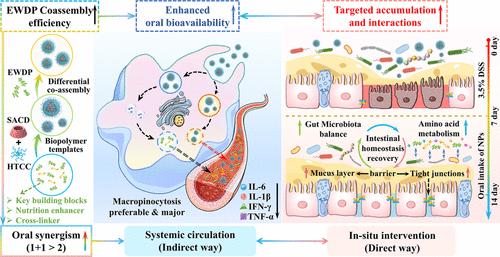Programmable Food-Derived Peptide Coassembly Strategies for Boosting Targeted Colitis Therapy by Enhancing Oral Bioavailability and Restoring Gut Microenvironment Homeostasis
IF 16
1区 材料科学
Q1 CHEMISTRY, MULTIDISCIPLINARY
引用次数: 0
Abstract
Orally targeting nanostrategies of multiple nutraceuticals have attracted increasing attention in ulcerative colitis (UC) therapy for superior patient compliance, cost-effectiveness, and biocompatibility. However, the actual targeting delivery and bioefficacy of nutraceuticals are extremely restricted by their poor solubility, interior gastrointestinal retention, and base permeability. Herein, we developed controllable colon-targeting nanoparticles (NPs) composed of a quaternary ammonium chitosan (HTCC) shell and succinic acid-modified γ-cyclodextrin (SACD) core for precise UC treatment. Egg white-derived peptides (EWDP, typical food-derived peptides) could not only function as potential cross-linkers to induce the differential coassembly with the above biopolymers but also aid the hydrophobic curcumin (Cur) solubility as well as nutrition enhancers for oral synergism of colitis therapy. More specifically, NPs with higher EWDP coassembly efficiency exhibited better pH-sensitive colloidal tunability (e.g., smaller size, higher rigidity, and roughness) and robust nutraceuticals (EWDP/Cur) coloading capacity (24.0–33.2% ≫ 10%, pH 2.0–7.0). Compared with pure nutraceuticals, NPs exhibited excellent cellular absorption (almost 10 times) and oral bioavailability (4.19–5.05 times) enhancement via faster mucus permeation and macropinocytosis transport, indirectly regulating the systemic inflammatory response. The sustainable sequential release and targeted accumulation profiles of NPs directly facilitated the interactions with the colonic microenvironment, verified by the intestinal barrier recovery and gut microbiota restoration. Moreover, the critical role of amino acid metabolism reconfirmed the importance of EWDP coassembly efficiency in maintaining intestinal homeostasis. Overall, this study would provide a facile, quantitative, and versatile perspective into the programmable design of food-derived peptide (e.g., EWDP) coassembled nanoplatforms for oral targeted therapy of UC.

通过提高口服生物利用度和恢复肠道微环境稳态来促进靶向结肠炎治疗的可编程食物来源肽共组装策略
口服靶向多种营养药物的纳米策略在溃疡性结肠炎(UC)治疗中越来越受到关注,因为它具有更好的患者依从性、成本效益和生物相容性。然而,营养保健品的实际靶向递送和生物功效受到其溶解度差、内部胃肠道滞留和碱渗透性的极大限制。在此,我们开发了由季铵壳聚糖(HTCC)外壳和琥珀酸修饰的γ-环糊精(SACD)核心组成的可控结肠靶向纳米颗粒(NPs),用于UC的精确治疗。蛋清衍生肽(EWDP,典型的食物衍生肽)不仅可以作为潜在的交联剂诱导与上述生物聚合物的差异共聚,还可以帮助疏水姜黄素(Cur)溶解度和营养增强剂用于口服结肠炎治疗的协同作用。更具体地说,具有较高EWDP共组装效率的NPs具有更好的pH敏感胶体可调性(例如,更小的尺寸,更高的刚性和粗糙度)和强大的营养药品(EWDP/Cur)负载能力(24.0-33.2% ~ 10%,pH 2.0-7.0)。与纯保健品相比,NPs通过更快的粘液渗透和巨噬细胞转运,表现出优异的细胞吸收(近10倍)和口服生物利用度(4.19-5.05倍),间接调节全身炎症反应。NPs的持续顺序释放和靶向积累特征直接促进了与结肠微环境的相互作用,并得到了肠道屏障恢复和肠道微生物群恢复的验证。此外,氨基酸代谢的关键作用再次证实了EWDP共组装效率在维持肠道稳态中的重要性。总的来说,这项研究将为食源性肽(如EWDP)协同组装纳米平台的可编程设计提供一个简单、定量和通用的视角,用于口服靶向治疗UC。
本文章由计算机程序翻译,如有差异,请以英文原文为准。
求助全文
约1分钟内获得全文
求助全文
来源期刊

ACS Nano
工程技术-材料科学:综合
CiteScore
26.00
自引率
4.10%
发文量
1627
审稿时长
1.7 months
期刊介绍:
ACS Nano, published monthly, serves as an international forum for comprehensive articles on nanoscience and nanotechnology research at the intersections of chemistry, biology, materials science, physics, and engineering. The journal fosters communication among scientists in these communities, facilitating collaboration, new research opportunities, and advancements through discoveries. ACS Nano covers synthesis, assembly, characterization, theory, and simulation of nanostructures, nanobiotechnology, nanofabrication, methods and tools for nanoscience and nanotechnology, and self- and directed-assembly. Alongside original research articles, it offers thorough reviews, perspectives on cutting-edge research, and discussions envisioning the future of nanoscience and nanotechnology.
文献相关原料
公司名称
产品信息
阿拉丁
γ-cyclodextrin
阿拉丁
ascorbic acid
阿拉丁
DiR dye
阿拉丁
5-amino-salicylic acid
 求助内容:
求助内容: 应助结果提醒方式:
应助结果提醒方式:


